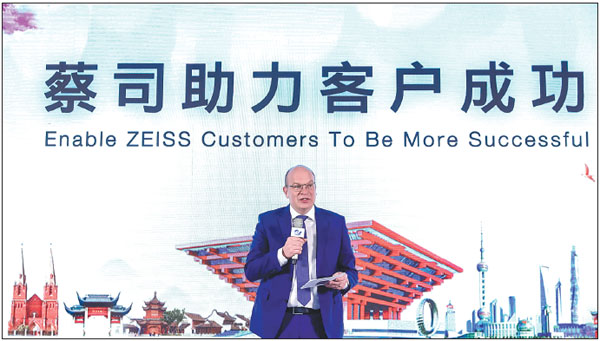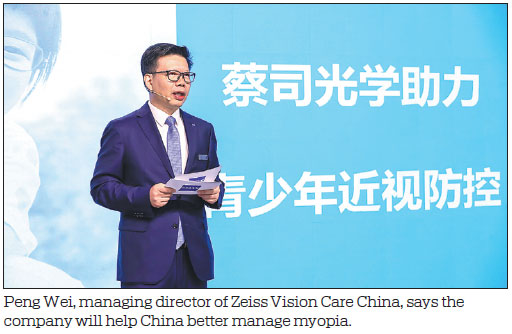Eyeing up the future with focus

Zeiss, the leading optic and optoelectronic products developer and manufacturer, headquartered in Germany, vowed to use its expertise to help China better manage widespread myopia among teenagers and children.
According to a report released by China's National Health Commission in June, more than 450 million Chinese suffer from shortsightedness. Its prevalence among Chinese primary school pupils is estimated at 30 percent, but the rate climbed to 60 percent for junior middle school students, 80 percent for those in senior middle school and 90 percent for college students.
China's central authorities have taken a series of actions in response to the situation. In August, eight Chinese ministries and departments including the Ministry of Education and the National Health Commission issued a plan aimed to reduce the overall myopia rate among teenagers by more than 0.5 percentage points per year from 2018 to 2023.

Matthias Metz, CEO of Zeiss Consumer Markets Segment, says Zeiss will enable customers to be more successful. Photos Provided to China Daily
"Zeiss is and will be engaged in contributing to the fight against myopia in China - for instance, with dedicated research and product development, with specific professional training for diagnosis and correction of myopia respectively," said Matthias Metz, member of the executive board of Carl Zeiss AG and CEO of Zeiss Consumer Markets Segment. "We will continue to put a lot of research and development resources into myopia to understand how we can better support the fight against myopia."
Over the past 20 years, Zeiss Vision Care, one of four business segments of Zeiss, has been making huge investments to develop myopia management solutions for Chinese children. Starting with peripheral defocus management single-vision lenses in 2010, the company has developed a wide range of products to serve youth' individual needs, for instance, for study and sports, according to Peng Wei, managing director of Zeiss Vision Care China.
"We should understand that there is no single key to open all locks," Peng said. "Lenses are not just about getting to see something, but to help to see the world better and naturally in different situations and provide protection for the eye.
"The key driver for innovations is the market and customer needs. Different kids, different needs."
During the 2019 China (Shanghai) International Optics Fair, which ran from Feb 21 to 23, Zeiss Vision Care exhibited a series of state-of-the-art myopia management and digital solutions. Exhibits included Zeiss' latest digital 3D centration platform, which allows more accurate centration to maximize optical performance. Also, there was a myopia management spectacle lens portfolio designed for children aged 6 to 12. The portfolio, which consisted of two lens concepts, named ZEISS MyoVision Pro and ZEISS MyoKids, was designed to reduce myopia progression and better meet individual needs of myopic children, according to the company.
Apart from introducing more innovative products dedicated to children, the company is also committed to helping parties such as governments and schools to increase awareness of myopia and train more opticians in China to provide advice to consumers, according to the company.
Over the past three years, more than 90,000 eye-care professionals and customers in China received training provided by Zeiss Vision Care, said the company.
"We will support activities to increase awareness of consumers because education and information about myopia and different ways to manage it are essential," said Metz.
Developed in Germany and China over the past 20 years, Zeiss Vision Care's offering to Chinese consumers includes much more than myopia management solutions. It introduced ZEISS DriveSafe, which is an all-day lens for car drivers, ZEISS EnergizeMe, which is a special design for contact lens wearers and ZEISS Digital Lenses, which are designed for people aged mid-30s onward with pre-presbyopic conditions.
Zeiss Vision Care was one of the first businesses to offer clear lenses with sunglass-like full ultraviolet rays protection up to 400 nanometers in the world. The company said this sets a new standard - it will help millions to protect their eyes better and avoid the harmful impact of UV on their sight.
Zeiss' success in the eye and vision care sector, Metz stressed, should be attributed to its achievements in ophthalmology, which can be traced back to 1912.
Its expertise in ophthalmology ensured Zeiss has a better understanding of customers' demands and could offer solutions to people suffering from myopia, he said.
"That helped us to bring experience to our vision care business and improve everything," Metz said. "Not only lenses themselves but also how the refraction is done, how the right lenses are taken for a particular customer. With this approach, we can enable customers to find a perfect solution, from refraction and lens consultation to dispensing technology."
"Our target here is to bring real value to consumers' daily life and to enable our customers and opticians to provide the best possible vision care solutions to consumers," Metz said.
Looking ahead, Zeiss is positive about growth of the vision care business in China.
"China experienced tremendous growth over the last few years (for our vision care business). I would expect we can continue this high growth," Metz said.
"I think we can reach more consumers with innovations we have in the market and innovations to come, with our full focus on the success of our customers."

MOST POPULAR
- 1 China to give visa-free treatment to another 9 countries
- 2 China fully opens manufacturing sector to foreign investors in landmark opening up move
- 3 China's import expo attracts record-breaking participating countries, exhibitors
- 4 China's door opening even wider to foreign visitors, businesses
- 5 China revises rules to ease foreign strategic investment in listed firms
Editors' Picks
 Video:
Peru sees new port open
Video:
Peru sees new port open
 Infographic:
China's public holidays for 2025
Infographic:
China's public holidays for 2025
 Infographic:
Basic facts of APEC
Infographic:
Basic facts of APEC
 Infographic:
Wrapping up the 7th CIIE: Data recap
Infographic:
Wrapping up the 7th CIIE: Data recap



